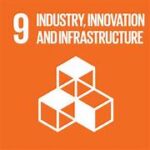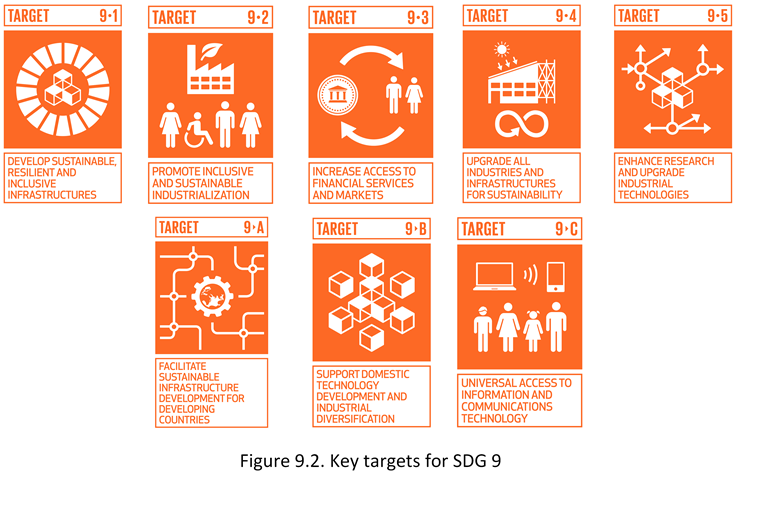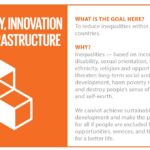Introduction
Goal 9 of the United Nations’ Sustainable Development Goal or SDG 9 is centred on building resilient infrastructure, industrialization for Development and Technology. These three factors are the main prerequisites for stability and development, the increase of peoples’ overall well-being, and economic well-being. Such aspects make industries and infrastructure relevant to massive global issues like poverty, inequality, environmental deterioration, and instability within the global economy.
By investing in robust infrastructure, governments and organizations can improve transport systems, energy supply, and communication networks, enhancing economic and social development. Inclusive and sustainable industrialization ensures that industries operate in an environmentally responsible manner while fostering economic equality. Innovation, particularly in technology and industrial processes, is key to addressing global challenges and advancing human progress.
Importance of Industry, Innovation, and Infrastructure
Infrastructure, industry, and innovation form the backbone of any prosperous society. Without adequate roads, bridges, power supplies, or technological innovations, it’s nearly impossible for economies to grow or for people to have access to basic services. More importantly, these elements drive sustainable practices, including renewable energy adoption, green technology advancements, and equitable industrial growth that addresses the needs of all individuals.
The Role of Industry in Sustainable Development
Contribution of Industry to Economic Growth
Development, growth and technology are the pillars of any development society. Without required roads, bridges, power supplies or technology, for the economic or any people’s growth it is almost equally impossible. But more importantly, these elements foster sustainable development, such as ensuring the use of renewable resources; improving on green technology; ensuring that industries grow in a way that meets everyone’s needs including the needy.
Sustainable Industrialization and Job Creation
Sustainable industrialization not only stimulates economic activity but also focuses on creating decent jobs that respect labour rights and promote workplace safety. In developing countries, the challenge often lies in balancing industrial growth with environmental sustainability. By adopting green technologies and encouraging industries to adopt circular economy models, countries can ensure that industrialization drives growth without causing environmental harm.
Industrial Innovation in the 21st Century
The 21st century global narrative has shifted towards industrialization through appreciation of technological growth, thereby underlining industrial modernization as a critical ingredient of development. Beginning from the industrial automation to renewable energy, industries are advancing rapidly at an unparalleled rate. Those nations that have adopted industrial innovations benefit in ways of increasing their competitive edge, cutting on costs and increasing productivity.
- Building Resilient Infrastructure
Importance of Infrastructure for Economic Stability
Infrastructure underpins economic stability. Reliable transport systems, robust power grids, and modern communication networks facilitate trade, improve access to markets, and enhance productivity. Inadequate infrastructure, however, limits growth potential and hampers the delivery of essential services, particularly in rural or underdeveloped areas.
Role of Infrastructure in Social Inclusion
Social inclusion is closely linked to infrastructure development. Building inclusive infrastructure, such as public transport systems, digital communication networks, and energy grids that reach underserved populations, enables equal access to economic opportunities. This is critical for reducing inequalities and ensuring that no one is left behind in the pursuit of development.
Sustainable and Green Infrastructure Development
The global shift towards sustainable infrastructure development is an important part of achieving SDG 9. Green infrastructure integrates environmental concerns with infrastructure projects, ensuring that these developments do not exacerbate climate change or biodiversity loss. From renewable energy plants to sustainable urban transport systems, investing in eco-friendly infrastructure is crucial for achieving long-term sustainability.
- The Significance of Innovation in Global Development
How Innovation Drives Economic Growth
Any economic stability is, therefore, based on infrastructure. Transportation infrastructure, efficient electricity supply and telephone and telecommunication infrastructures promote trade, market access, and efficiency. Lack of infrastructure, however, constrains development and exercises a negative impact on delivery of needed services especially in rural or developing countries. For the purpose of propagating social inclusion, what part does infrastructure play? First of all, social inclusion is a process that has a strong relationship with infrastructure investments. Accomplishing social infrastructure that connects the disadvantaged in such field as transportation, information and energy all lead to equal opportunity marketplace. This is crucial in the fight against inequality and in the process to have a departure after setting the pace that nobody will be left behind.
Technological Innovations for Sustainability
Innovation plays a critical role in addressing environmental challenges. Advances in green technologies, such as solar power, electric vehicles, and waste recycling systems, help reduce pollution and lower carbon footprints. In addition, digital technologies such as artificial intelligence (AI) and the Internet of Things (IoT) offer solutions for improving resource management and industrial productivity.
Encouraging Inclusive Innovation Policies
To ensure that innovation benefits everyone, inclusive policies are essential. Governments must prioritize investments in research and development (R&D), particularly in areas that address the needs of marginalized communities. Supporting local innovators and small businesses can also foster grassroots solutions to local challenges, contributing to more equitable development.
- Challenges in Achieving SDG 9
Lack of Investment in Infrastructure
One of the greatest obstacles to achieving SDG 9 is the lack of sufficient investment in infrastructure, particularly in developing nations. Without adequate financial resources, many countries struggle to build or maintain the necessary infrastructure to support economic and social development.
Barriers to Industrialization in Developing Countries
For many developing nations, industrialization is hindered by inadequate infrastructure, poor access to technology, and lack of skilled labor. Additionally, stringent environmental regulations may impose financial and operational burdens on industries trying to grow sustainably. This makes it imperative for these countries to receive technical assistance and financial support from the global community.
Innovation Gaps and Digital Divide
The digital divide – the gap between those who have access to modern technologies and those who do not – is another challenge. Bridging this divide is crucial for ensuring that innovation benefits all individuals, regardless of their socioeconomic background or geographic location.
- SDG 9 Targets and Indicators
Overview of SDG 9 Targets
SDG 9 outlines eight targets aimed at improving infrastructure, fostering inclusive and sustainable industrialization, and encouraging innovation.
These targets focus on areas such as improving access to quality, reliable, and sustainable infrastructure, upgrading industries to be more sustainable, increasing the access of small-scale industries to financial services, and enhancing scientific research and technological capacity.
Target 9.1: Develop Resilient Infrastructure
Goal: Develop quality, reliable, sustainable, and resilient infrastructure to support economic development, with a focus on affordable access for all.
Indicators:
– Proportion of rural population with access to roads.
– Passenger and freight volumes by mode of transport.
Target 9.2: Promote Sustainable Industrialization
Goal: Promote inclusive and sustainable industrialization, increasing industry’s share of employment and GDP.
Indicators:
– Manufacturing value added as a percentage of GDP.
– Manufacturing employment as a percentage of total employment.
Target 9.3: Improve Access to Finance for Small Enterprises
Goal: Increase access of small-scale industries to financial services, including affordable credit.
Indicators:
– Proportion of small-scale industries with a loan or line of credit.
Target 9.4: Upgrade Infrastructure for Sustainability
Goal: Upgrade infrastructure and retrofit industries to make them sustainable, with increased resource efficiency and clean technologies.
Indicators:
– CO2 emissions per unit of value added.
Target 9.5: Enhance Research and Innovation
Goal: Enhance scientific research and upgrade industrial technologies, particularly in developing countries.
Indicators:
– Research and development (R&D) expenditure as a percentage of GDP.
– Number of researchers per million inhabitants.
Target 9.a: Support Infrastructure Development in Developing Countries
Goal: Facilitate sustainable and resilient infrastructure development in developing countries through financial and technical support.
Indicators:
– Total official international support to infrastructure.
Target 9.b: Promote Domestic Technology Development
Goal: Support domestic technology development and industrial diversification in developing countries.
Indicators:
– Proportion of medium and high-tech industry value added in total value added.
Target 9.c: Improve Access to Information and Communication Technology
Goal: Significantly increase access to ICT and strive to provide universal, affordable internet access in least developed countries by 2020.
Indicators:
– Proportion of the population covered by a mobile network, by technology.
It’s to help track global progress towards building infrastructure that supports sustainable industrialization and drives innovation across nations.
SDG 9 and Its Relevance to India
India, being one of the fastest-growing economies in the world, plays a pivotal role in achieving SDG 9. The country’s efforts to modernize its infrastructure, boost industrial growth, and foster innovation are central to its development agenda. With a population exceeding 1.4 billion and a rapidly expanding urban sector, India’s focus on inclusive industrialization and resilient infrastructure is critical for sustained economic progress.
Infrastructure Development in India
India faces significant challenges in developing its infrastructure, particularly in rural areas where access to basic amenities such as roads, electricity, and clean water is often limited. However, the government has launched several initiatives aimed at improving infrastructure across the country.
Key Infrastructure Initiatives:
- Bharatmala Pariyojana: A nationwide highway development program aimed at improving road connectivity to boost trade and employment opportunities.
- Smart Cities Mission: Aims to develop 100 smart cities with modern infrastructure and sustainable urban solutions, making cities more livable and economically viable.
- Pradhan Mantri Gram Sadak Yojana (PMGSY): Focuses on providing all-weather road connectivity to rural areas to enhance access to markets, education, and healthcare.
- Sagarmala Project: Enhances the development of port infrastructure and coastal economic zones, aiming to improve maritime connectivity and support industrialization along the coastal belt.
Industrialization in India
India’s industrial sector is growing rapidly, but it still faces challenges such as labor-intensive production methods, energy inefficiency, and lack of access to advanced technologies. Despite these hurdles, the Indian government is pushing forward with plans to promote sustainable industrialization.
Key Industrialization Initiatives:
- Make in India: Launched in 2014, this initiative encourages companies from around the world to manufacture in India. It aims to transform India into a global manufacturing hub by focusing on sectors such as automotive, textiles, electronics, and chemicals.
- National Manufacturing Policy: Seeks to increase the share of manufacturing in GDP to 25% and create 100 million jobs by 2025.
- Micro, Small and Medium Enterprises (MSMEs): These play a vital role in India’s industrial ecosystem. The government has introduced various schemes to support MSMEs, including access to finance, technology upgradation, and skill development.
Innovation and Technological Progress in India
India has become a global leader in technological innovation, particularly in sectors such as information technology (IT), pharmaceuticals, and space exploration. The government has made considerable investments in research and development to foster innovation and entrepreneurship.
Key Innovation and R&D Initiatives:
- Digital India: Launched in 2015, this initiative aims to digitally empower India by increasing internet connectivity and promoting digital literacy. It also supports innovation through initiatives like startup incubation centres and research grants.
- Atal Innovation Mission (AIM): AIM is a government platform designed to foster innovation and entrepreneurship across schools, universities, and industries. It supports incubators, startups, and innovation labs to enhance India’s R&D capabilities.
- National Innovation Council: Established to facilitate collaboration between the government, private sector, and academia to drive innovation in key sectors such as agriculture, energy, healthcare, and education.
Resilience and Sustainability: Key Challenges for India
While India has made significant strides in achieving the targets of SDG 9, there are still hurdles to overcome, particularly in the areas of sustainability and resilience.
Environmental Impact: Industrialization often leads to increased pollution and resource depletion. Balancing economic growth with environmental sustainability is a major challenge for India, particularly in sectors like manufacturing and energy.
Rural-Urban Divide: The benefits of infrastructure development and industrialization are often unevenly distributed. Many rural areas still lack basic infrastructure, while urban areas continue to expand rapidly. Bridging this divide is essential for inclusive growth.
Access to Finance: Small-scale industries and entrepreneurs, especially in rural areas, often face difficulties accessing affordable credit and financial services. The government has introduced measures to improve financial inclusion, but more needs to be done to ensure equitable access to financial resources.
Key Successes of India in Achieving SDG 9
Despite the challenges, India has achieved several notable successes in its journey towards SDG 9. The country has emerged as a global leader in industries like pharmaceuticals, textiles, and IT, and it has made significant investments in research and development. The expansion of mobile networks and internet connectivity has revolutionized access to services and information, particularly in rural areas.
Examples of Success:
- ISRO’s Space Missions: The Indian Space Research Organization (ISRO) has achieved global recognition for its cost-effective space missions, including the Chandrayaan and Mars Orbiter Mission (Mangalyaan). These innovations have positioned India as a leader in space technology.
- India’s Renewable Energy Growth: India has made significant progress in the renewable energy sector, particularly in solar and wind energy. The country has set ambitious targets to achieve 450 GW of renewable energy capacity by 2030.
The Role of Private Sector and MSMEs
The private sector, especially Micro, Small, and Medium Enterprises (MSMEs), plays a crucial role in driving innovation and sustainable industrialization in India. MSMEs account for a significant share of India’s manufacturing output, employment, and exports. Initiatives like Startup India and the Credit Guarantee Fund Trust for Micro and Small Enterprises (CGTMSE) provide support to young entrepreneurs and small businesses, fostering a culture of innovation.
Achieving SDG 9 by 2030: What’s Next for India?
India’s path towards achieving SDG 9 is a journey of continuous improvement, requiring a balance between rapid economic growth and sustainable development. To ensure long-term success, India will need to prioritize investment in infrastructure, foster a culture of innovation, and promote industrial policies that are inclusive, resilient, and environmentally sustainable.
Future Priorities for India:
- Green Industrialization: Focus on sustainable industrial practices that minimize environmental impact, reduce carbon emissions, and conserve natural resources.
- Digital Transformation: Continue to leverage digital technologies to modernize infrastructure, improve access to financial services, and promote innovation.
- Inclusive Growth: Ensure that the benefits of infrastructure and industrial growth are shared across all regions and social groups, particularly marginalized communities in rural areas.
Conclusion
SDG 9, with its focus on industry, innovation, and infrastructure, plays a crucial role in shaping a sustainable future. For India, achieving SDG 9 will require continued efforts to modernize infrastructure, promote inclusive industrialization, and foster innovation. Balancing rapid economic growth with sustainability and social inclusion will be essential for India’s long-term development. By embracing green technologies, supporting MSMEs, and investing in research and innovation, India is well-positioned to make significant strides towards meeting the goals of SDG 9 by 2030.
References and links:
United Nations Sustainable Development Goals: UN SDG 9 Official Page
https://sdgs.un.org/goals/goal9
India’s Initiatives for SDG 9:
- Bharatmala Pariyojana: Nationwide highway development program for improved connectivity.
- Make in India: Focus on transforming India into a global manufacturing hub.
- Digital India: Aims to empower digital infrastructure and literacy.
https://pib.gov.in/PressReleasePage.aspx?PRID=2032857
https://www.globalgoals.org/goals/9-industry-innovation-and-infrastructure/
https://www.drishtiias.com/daily-updates/daily-news-analysis/niti-aayog-sdg-india-index-2023-24







